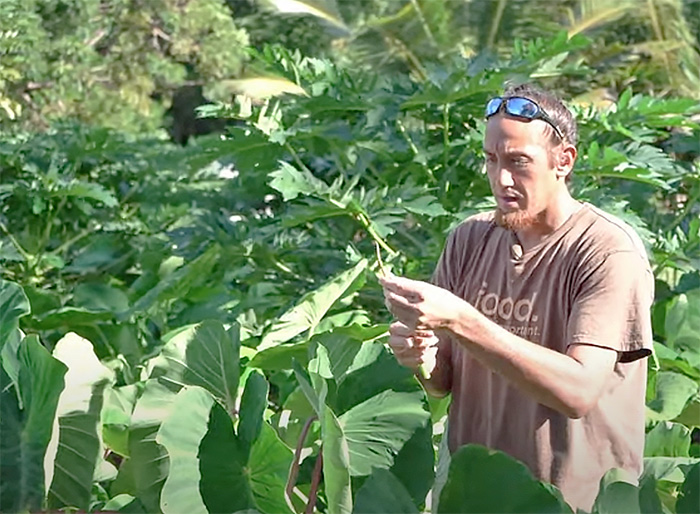This is a fascinating presentation on growing and processing taro traditionally:
‘Though we have taro growing in our Grocery Row Gardens, we haven’t utilized it as I am not that familiar with harvest times and processing. We can sure grow it, but preparing it is a different animal. Er, plant.
If you mess up your timing and/or cooking, the calcium oxalate crystals (raphides) in taro will punish you when you eat it!
I knew a family that planted lots of food plants in their small Summerfield backyard, years ago. Later, a retired couple (who I also knew) bought the property from them. They were told about the various crops and that many of them were edible, including the roots of the “elephant ears” around the back door.
One day, the wife dug one and cooked it for her husband. He ate some, and then his throat, mouth and lips began to burn horribly. He suffered awful pain for a time before it passed, and they were afraid he had been poisoned. The root had not been cooked well enough, and the remaining calcium oxalate crystals inflamed and tormented him greatly.
After this experience, they ripped out the unfamiliar edible roots in their backyard, both taro and true yams, and never tried again.
It is good to learn from an expert when you are preparing an unfamiliar crop. Some plants fight back.
Definitely don’t do what this lady did and make a green smoothie from the leaves (language and horrible story warning!).
We’d like to start using our taro better. Does anyone else have experience with it? Share your story in the comment!


2 comments
I am trying to grow taro in my unused worm bin, but I am in the Pacific Northwest and taro really doesn’t grow here. The best I have ever gotten was about three leaves the size of my hand, though I had one corm survive the winter outside one year, which was a real surprise. The current attempt is to get better growth. Since taro will grown in shallow water, I figured the water in the tub should cushion it against the chilly summer nights a bit more than a planter on the south wall did.
I will probably never get enough grown to eat, so I don’t have a clue what to do with them outside of making poi.
Yeah those ladies paid the price from improper preparation. I’m not into eating the leaves, but even when preparing the root it can irritate (itchy) your hands so u can either where gloves or coat you hands in oil.
I’m growing 3 types of “taro”: Puerto Rican = malanga similar to ones sold in stores; Hawaiian Red taro a very large traditional poi tuber; and a Japanese dasheen /eddo which are smaller roundish tubers about the size of a tennis ball at best. With that said I tend to prefer the safer preparation dishes that boil or pre-boil/par-boil the roots and then continue to cook further. Especially as different taro has more or less of the oxalates.
I used to travel to Japan for work once a quarter for about 10 years and one of my favorite taro dish is Simmered Taro (Satoimo no Nimono). Was sweet and savory. I cook this now but the ingredients are pretty specific and not in most folks kitchens.
Another dish is Sancocho – Puerto Rican (Caribbean) Beef Stew. This also often uses yams and plantain so u can leverage some other thing u are growing.
Lastly love fried (who doesn’t) versions like chips. Also, I use to make a ” latke (potato pancake) ” knockoff type of dish. A good practice is to presoak the peeled taro (ovenight is best) in cold water before frying to remove more of the oxalates. Soaking in water as u process is good idea in general as taro browns quick like potatoes and apples.
As u can see I tend to go to the cultural source for recipes as to where these plants naturally grow and people have been cooking them for eons. U can also experiment with other potato type uses, just make sure u cook it thoughly and properly (Boil, roast or fry!).
From South Florida @stokedonearth
Comments are closed.